2015 was a big year for 18F. We almost doubled in size, worked with 28 different agency partners, and released products ranging from Design Method Cards to cloud.gov. Internally, we improved onboarding and our documentation by releasing guides on topics as diverse as content, accessibility, and creating good open source projects.
To mark the end of the year, we reached out to everyone at 18F and asked them to reflect on a meaningful project they worked on this year. We didn’t define “meaningful” — for some people, it was the main product they worked on; for others, it was developing a relationship with a partner agency or learning about a new tool. Below, everyone at 18F shares what they learned, what they did, and how they grew.
- Accessibility
- Blog
- HTTPS
- Diversity Working Group
- Products We Shipped
- Guides, Resources, and Tools
- Process and Documentation
- Growing our Team
Accessibility
The White House Office of Science and Technology Policy, 18F, the National Institute on Disability, Independent Living, and Rehabilitation Research, and DC Legal Hackers hosted an Accessibility Hackathon on March 31, 2015.
“I loved organizing the accessibility hackathon and it’s been a blast working on the micropurchase experiment and the Agile BPA work.” - Alan deLevie
 Photo: Jameson Dempesy
Photo: Jameson Dempesy
Blog
We published over 130 posts this year on our blog and featured 70 team members and 10 guests as authors.
“The projects I covered for the blog, most recently USEITI, were an amazing opportunity to hear about how our developers and designers approach making a better government for the American public.” - Greg Boone
“I’m very proud of all the work that went into the blog this year including the wide range of posts we’ve published, the improved editing process, and all the new authors and voices we were able to represent.” - Andre Francisco
HTTPS
18F worked with government teams to help submit a number of government domains to be hardcoded as HTTPS-only. Eric Mill wrote blog posts explaining that effort and the importance of HTTPS. Unsurprisingly, he chose the HTTPS work as the most enjoyable project he worked on this year.
“I thoroughly enjoyed helping agencies get their .gov domains hardcoded into browsers as secure.“ - Eric Mill
 Since we wrote about it in February, 14 more.gov domains have been fully preloaded.
Since we wrote about it in February, 14 more.gov domains have been fully preloaded.
Diversity Working Group
18F is home to many working groups that spin up to collectively address an issue or solve a problem. Several of our colleagues cited their work with the Diversity Working Group as their most meaningful project this year. The Diversity Working Group helps make 18F a great place to work for people of all backgrounds, and is working to address inequalities that exist in the tech sector.
“I really enjoyed working with the Diversity Working Group because it’s shown me that 18F is the most committed to improving inclusion out of anywhere I’ve ever worked.” - Amanda Robinson
“I really enjoyed working with the Diversity Working Group this year because I witnessed how committed they are to making 18F a diverse, inclusive, welcoming place to work.” - Holly Allen
“I’ve really enjoyed being part of the Diversity Working Group this year. I’ve mainly learned a lot more detail about how big the problem is of diversity in tech. I’m very hopeful that we will do all that we can here to address it.” - Jacob Harris
Products we shipped
analytics.usa.gov
In March, we worked with the Digital Analytics Program, the U.S. Digital Service (USDS), and the White House to build and host a dashboard showing U.S. federal government web traffic.
“I really enjoyed working on analytics.usa.gov. Being empowered to build a MVP quickly and well and keep iterating it was very refreshing.” - Gray Brooks
“I feel honored to be part of the analytics.usa.gov team every time I see another government office use our open source project to make their analytics data publicly available.” - Gabriel Ramirez

betaFEC
We worked with the Federal Election Commission (FEC) to make campaign finance data more accessible to the public. In October, we launched betaFEC, the first piece in a complete redesign of the FEC’s online presence. The project allowed us delve into intricate campaign finance data, plain language, and the FEC’s first API.
“I loved working on the team that helped make betaFEC because I got to work closely with a smart, talented team of public servants at the FEC.” - Noah Manger
“I loved working on the team that helped make betaFEC. It was especially exciting to help our partners at the FEC find how they wanted to express their agency through a modernized web experience, and build an updated look and feel with them.” - Jennifer Thibault

CALC
We worked with GSA to launch a powerful new labor category and pricing research tool to help the federal contracting community make smarter, faster buying decisions.
“Working on CALC was meaningful to me, because I know it is saving people hours of work every week, and saving the taxpayers millions of dollars.” - Nick Brethauer
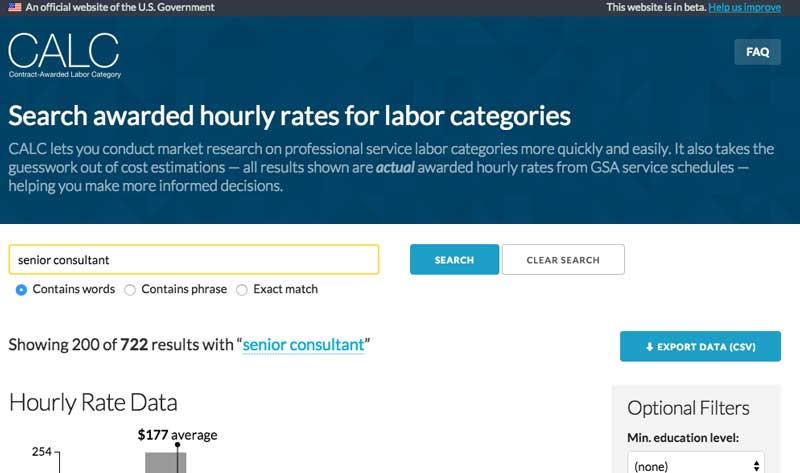
cloud.gov
We scaled our infrastructure expertise and created our own Platform-as-a-Service called cloud.gov. The platform frees teams to focus on creating quality services securely hosted in the cloud and uses only FedRAMP authorized, FISMA-ready, hardened machine images, which allows teams to focus on software features and security.
“I’m really proud of the work on the cloud.gov landing site and blog posts. It cemented the idea of Platform-as-a-Service in a lot of minds previously unfamiliar with the concept, and helped us measure the appetite for the service, validating that we were building the right thing before spending a lot more effort to prepare it for rollout to the agencies.” - Bret Mogilefsky
“I have really enjoyed working on cloud.gov because it has allowed me to reconnect with my devops roots, and exposed me to the continuous integration platform Concourse CI which helps me spread the love for AUTOMATING ALL THE THINGS!” - M. Adam Kendall
“cloud.gov has the potential to revolutionize how the government thinks about deployment, security and running systems. I am pretty proud of what we built so far and look forward to see what 2016 brings.” - Diego Lapiduz
“Many of us have experienced firsthand how security compliance requirements may hinder the government’s ability to ship new projects. I’m proud to be working on methods for accelerating the compliance process in the open and excited to see the support and contributions of the open source community.” - Gabriel Ramirez

College Scorecard
In September, 18F worked with USDS and the Department of Education on College Scorecard, a clearinghouse to provide the clearest, most accessible, and reliable national data on college cost, graduation, debt, and post-college earnings.
“I really enjoyed working with USDS, 18F and the Department of Education on https://collegescorecard.ed.gov because it demonstrated how multiple agencies can come together to build something great.” - Ozzy Johnson
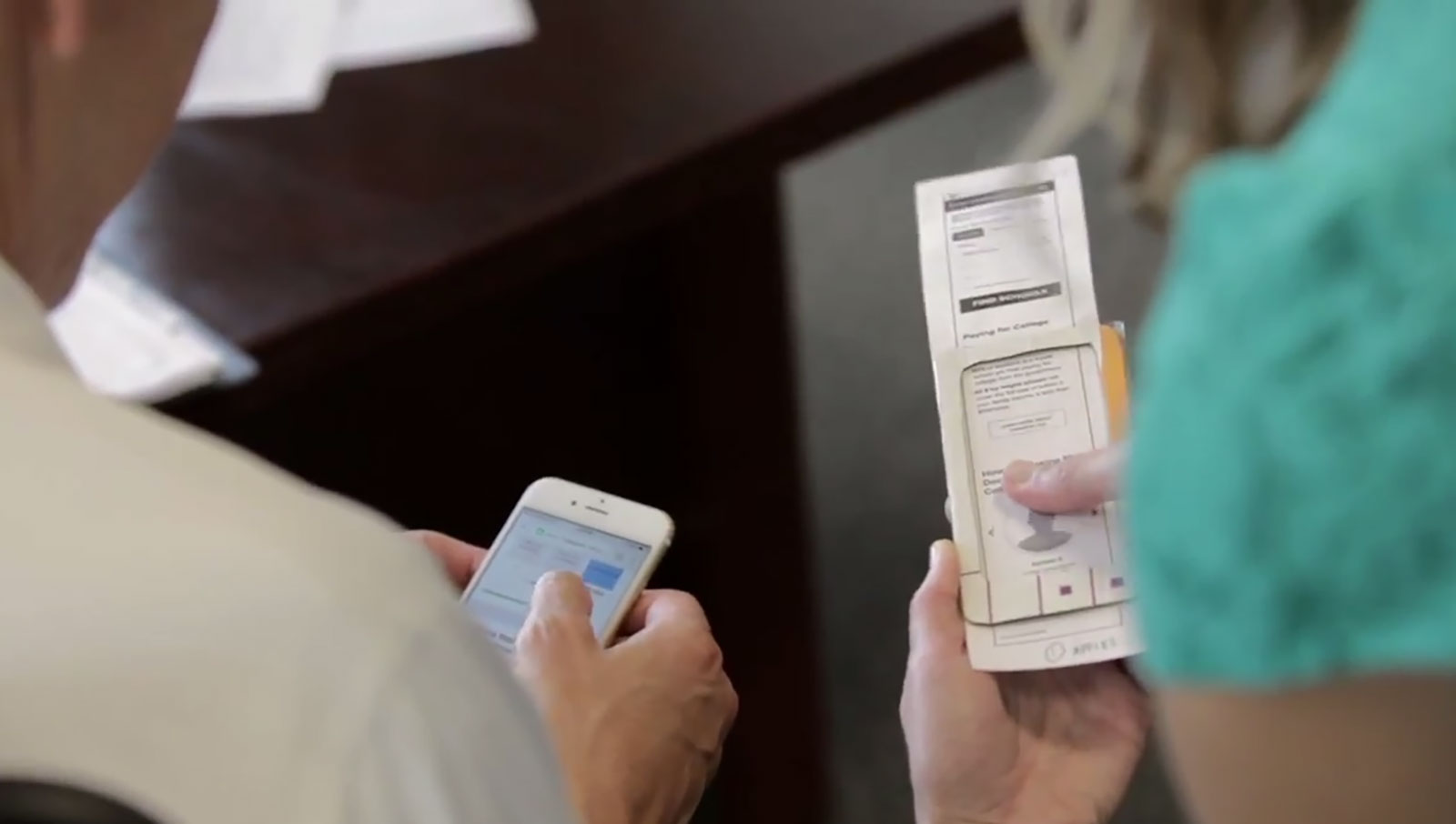
DATA Act
In May 2014, President Obama signed the Digital Accountability and Transparency Act (DATA Act) into law. Once implemented, the DATA Act will make it easier to understand how the federal government spends money. The Department of the Treasury and the Office of Management and Budget (OMB) are leading the implementation, and Treasury has partnered with 18F Consulting to help with a few aspects of the project.
“The best thing I worked on was the DATA Act. In 2012, I first wrote about DATA Act. In 2013, I visited my reps on Capitol Hill about voting for it. In 2014, I went to the Treasury’s federal spending data town hall and kvetched about poor data quality. And then in 2015, I worked with those same Treasury folks to get it fixed.” - Becky Sweger
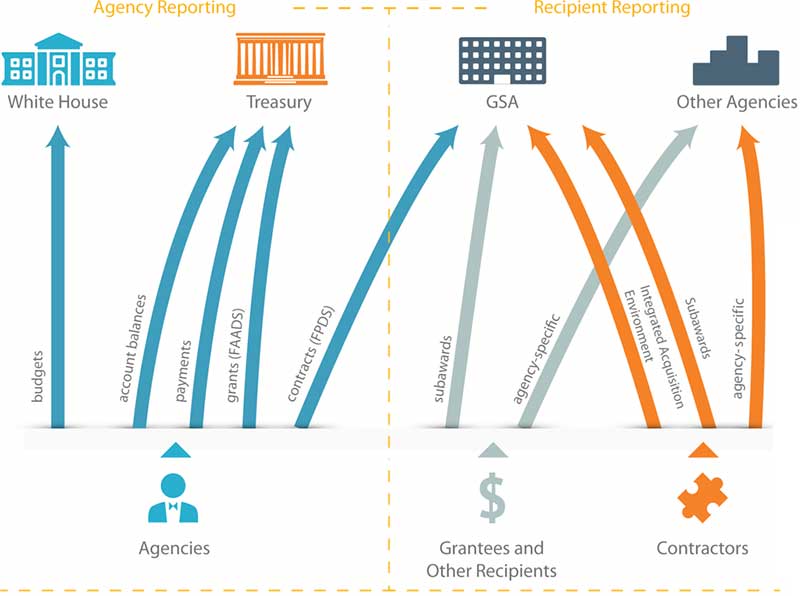 Image courtesy of the Data Transparency Coalition
Image courtesy of the Data Transparency Coalition
Draft U.S. Web Design Standards
In September, 18F worked with USDS to release the U.S. government’s very own set of common UI components and visual styles for websites. It’s a resource designed to make things easier for government designers and developers, while raising the bar on what the American people can expect from their digital experiences.
“I’m really proud of the Draft U.S. Web Design Standards because it’s the first step at improving government website experiences at scale and creating and supporting a community around them. (By the numbers….we’ve accepted 397 contributions from 49 people. We’ve had 207 people participating in conversations on GitHub issues and 128 people who have submitted GitHub issues. We’ve had 46 code developers — 3 core, 6 regular, and 33 casual users.)” - Maya Benari
“I am honored to have worked on the Draft U.S. Web Design Standards with an amazing group of talented colleagues. It’s truly awesome to see the impact our work has already made and will hopefully continue to make for years to come.” - Julia Elman
“I was lucky to get to coach along some smart folks with the Method Cards and a tiny bit around the Draft U.S. Web Design Standards. Mostly, my role has me looking for more opportunities for the design team to lead, and I’m really proud of them for all the work that they’ve done this year. I feel lucky, every day, to get to work with such an amazing group of people.” - Russ Unger
“I’m proud to have started a project that will make the U.S. [Draft] Web Design Standards easier to use for the >25% of U.S. government websites that run on Drupal. I’m working with members of the larger Drupal community as well as people in government to help these standards scale without the need for custom development.” — Rhys Fureigh
 The U.S. Web Design Standards are designed to be viewed on any device.
The U.S. Web Design Standards are designed to be viewed on any device.
U.S. Extractive Industries Transparency Initiative
USEITI is part of an international effort to promote open and accountable management of natural resources. 18F worked with a cross-sector partnership between government (agencies that oversee extraction in the U.S.), industry (companies operating in the extractive industries), and civil society (individuals and organizations that represent community and citizen interests) to provide data about how the U.S. manages extractive industries.
“EITI reports have traditionally been thick, printed PDFs full of statistics, meant for a specialist audience. It was so great to be a part of the U.S. process that is leading the world in making this data available online along with tons of rich contextual information to make it understandable.” - Michelle Hertzfeld

Every Kid in a Park
Earlier this year, President Obama formally announced the Every Kid in a Park program, which provides fourth graders and their families with free access to more than 2,000 federally-managed sites. 18F worked with the Department of the Interior to create the program’s website, which was written at a fourth grade level with the help of fourth graders.
“I really enjoyed working on Every Kid In A Park because I helped develop a project with an amazing team to help kids get to the park!” - Christine Cheung
“Working on the content design for Every Kid in a Park reminded me that government websites can be joyful, inclusive, and easy to read.” - Emileigh Barnes
 The Every Kid in a Park 404, not found page, designed for fourth graders.
The Every Kid in a Park 404, not found page, designed for fourth graders.
Federalist
The Federalist platform provides an easy way for agencies to publish static government websites. The first group to use the platform, the White House’s Social and Behavioral Sciences Team, launched their website in September. We also used Federalist on a number of other 18F projects including our own blog posts.
“The best thing I worked on this year has been Federalist, especially the launch of the website for the Social and Behavioral Sciences Team. Our team’s work amplified the reach of that team’s effort in support of an executive order. I was able to meet other people devoting much of their lives to making government serve people better. I’m honored to be a part of it.” - Gail Swanson
“I didn’t start working at 18F until the the fourth quarter of this year, making me a new person for most of my time here so far. However, I’ve still still felt incredibly inspired by every project I’ve contributed to and generally in awe of what this place is capable of. One of things I’ve been able to do is help the team building Federalist – a platform that helps agencies launch new websites quickly, with user research. It’s a project that is a clear example of the seemingly simple, yet revolutionary things 18F can do. It’s also an example of 18F’s mission marching forward and being implemented successfully.” - Ryan Sibley
“I’m really proud of the work I did on Federalist because it helped streamline the launch of sites that addressed college affordability data and the quantity of natural resources being extracted from federal lands.” - Jeremia Kimelman
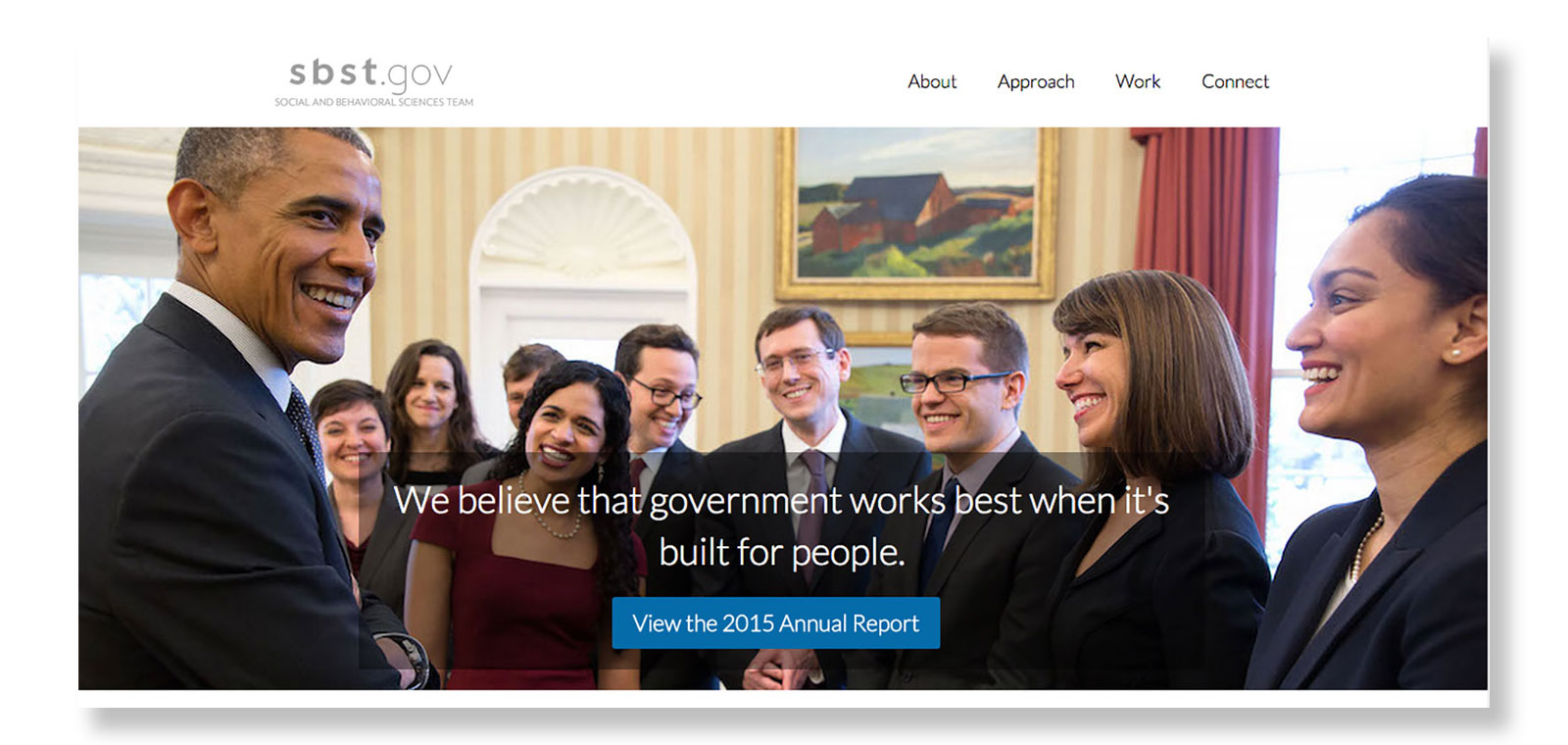 The Social and Behavioral Sciences team was the first adopter for Federalist.
The Social and Behavioral Sciences team was the first adopter for Federalist.
SBIR-EZ
This year, we worked with the Air Force on an application built on the FBOpen API to simplify, streamline, and unify the Small Business Innovation Research application process.
“I really enjoyed working on SBIR-EZ because it opened my eyes to a fascinating program for supporting small businesses.” - David Best
Treasury Department’s #TheNew10
We partnered with the Department of Treasury to develop the content, visual design, and social media campaign for the website announcing new $10 bill.
“I really enjoyed partnering with US Treasury to craft the digital strategy for #TheNew10. We’re putting a woman on the $10 bill!” - Kara DeFrias
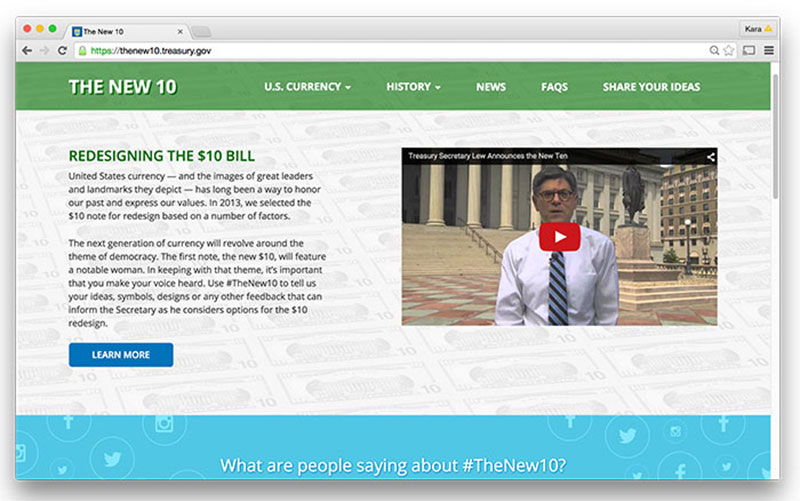
USCIS
18F has worked with USCIS to develop my.uscis.gov, a customer-facing site to help users navigate their relationship with the agency.
“This year I made an account system that helps immigrants keep their information up to date. It now has hundreds of thousands of users.” - Sasha Magee
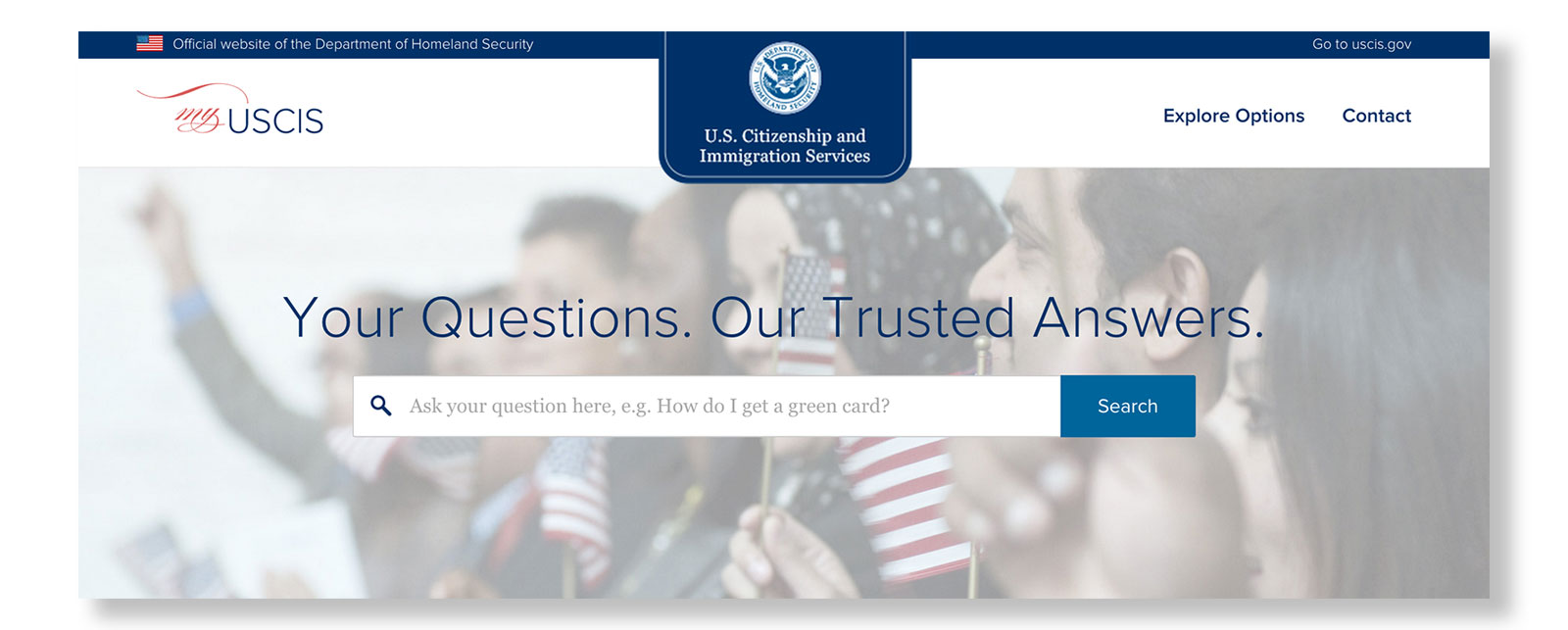
Guides, resources, and tools
Method Cards
We released a deck of method cards that help research and design teams communicate a shared vocabulary across teams and agencies.
“I loved working on the Method Cards. These are a tool that not only allows junior designers to easily learn new design skills, but they also allow a team to quickly create a shared language. It’s easy to talk about design and research in generalities, but using the method cards teams can pinpoint activities that best fit their need and gets them answers to questions that are slowing down the development process.” - Brad Nunnally
“The first thing I worked on at 18F was the Design Methods. Teaching tools of great design has been part of this job since I started, which means learning tools of great design has been part of this job since I started. I’ve never learned so much in such a small amount of time.” - James Hupp
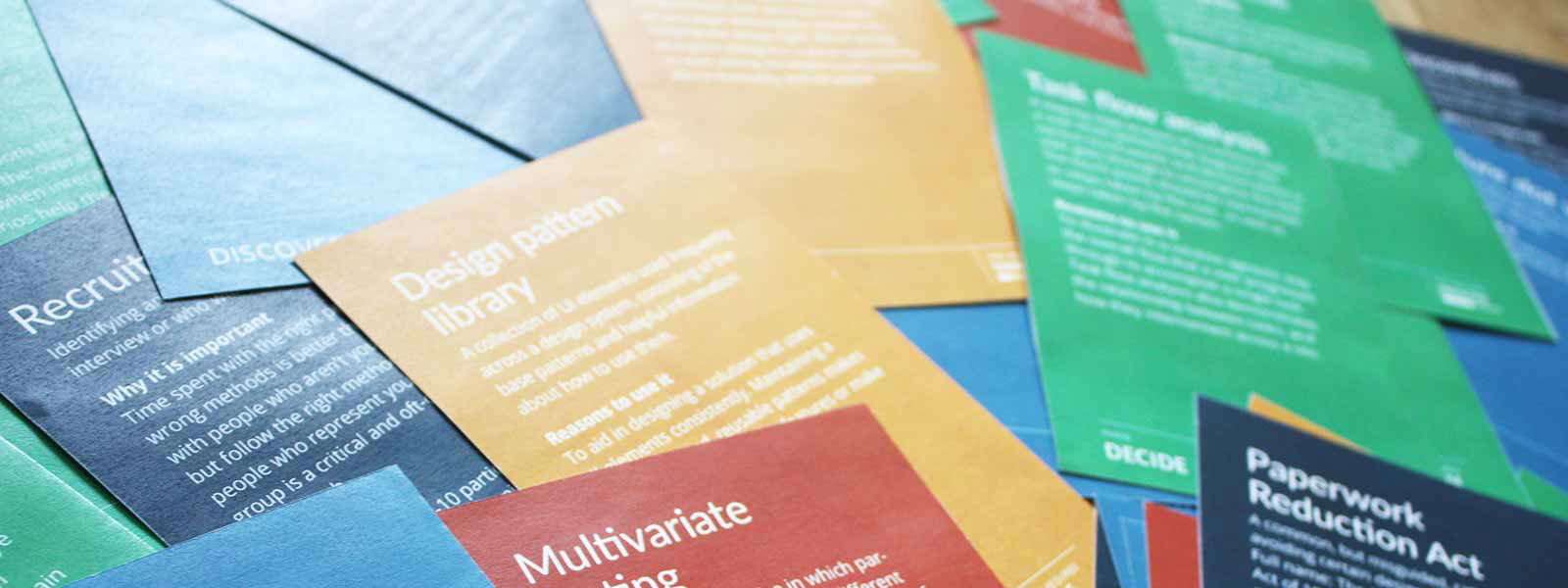 The 18F Design Method cards are open source to download and print off.
The 18F Design Method cards are open source to download and print off.
Partnership Playbook
If you or your agency have thought about working with 18F but are unsure of how we work with our partners, we have a new set of guidelines to help you out. The 18F Delivery Partnership Playbook is specifically targeted at federal offices interested in working with 18F to build digital services.
“I loved working on the MVP intake process and the Partnership Playbook to explain how 18F works with our partners!” - Will Slack
rdbms-subsetter
We wrote a new utility to automate extracting random yet relationally consistent subsets of relational databases.
“I loved working on rdbms-subsetter because people in the public developer community got excited about what we’re doing at 18F.” - Catherine Devlin
Writing Lab
We launched a Writing Lab for people to receive writing help from our content and outreach teams.
“This is a tough call, for sure: It’s been a momentous year, and I’m proud of all the work I’ve done here at 18F. If I were to choose one thing, I’d have to say the Writing Lab — we’ve offered on-demand, reliable content help to dozens of projects, and we’re gearing up to help lots more.” - Kate Garklavs
Procurement
In October, we used our “micro-purchase authority” to run an experiment: we contracted for contributions to a specific project and then wrote up what we learned.
“I really enjoyed working on the micropurchase project because helping government agencies quickly buy code is one of many ways that 18F can impact the federal procurement environment. The micropurchase experiment has the ability to make lasting culture change around open source software projects in government.” - Alla Goldman Seiffert
Partner meetings
Our consulting team routinely meets with agencies for agile workshops and short-term engagements. Several members from the team reflected on how much they enjoyed working with agencies this year:
“I really enjoyed participating in initial partner meetings to help evaluate the technical needs of proposed projects. It’s made me realize just how many government agencies are eager to move to an agile, user-centered way of working.” - Alex Bisker
“The Nuclear Regulatory Commission is pursuing activities to streamline and modernize their Security Accreditation Process. This was inspirational to me, because it represented an agency realizing the “status quo” could not continue and they reached out to 18F for our perspective, but not because they expected us to “hand hold” them through transformation. It has the support of their CIO and other leadership and will require them to transform culture, process, technology, and (most importantly) entrenched habits and expectations.” - Jay Huie
“I really enjoyed working with the EPA because I realized how committed their employees are to their mission — and how excited they are about adopting modern, improved digital practices.” - Randy Hart
“I’ve spent the last few months working with the pesticides division of the EPA, helping them modernize the way that pesticide labels are accessed and analyzed by inspectors. Pesticide labels are a surprisingly complex and important thing to get right, because when they’re wrong people can (and do) die. Bringing modern technology into the work the field inspectors do every single day is going to significantly improve their ability to do their job, and I feel incredibly lucky to get to help with that and know that what I’m doing could genuinely help save lives.” - Lane Becker
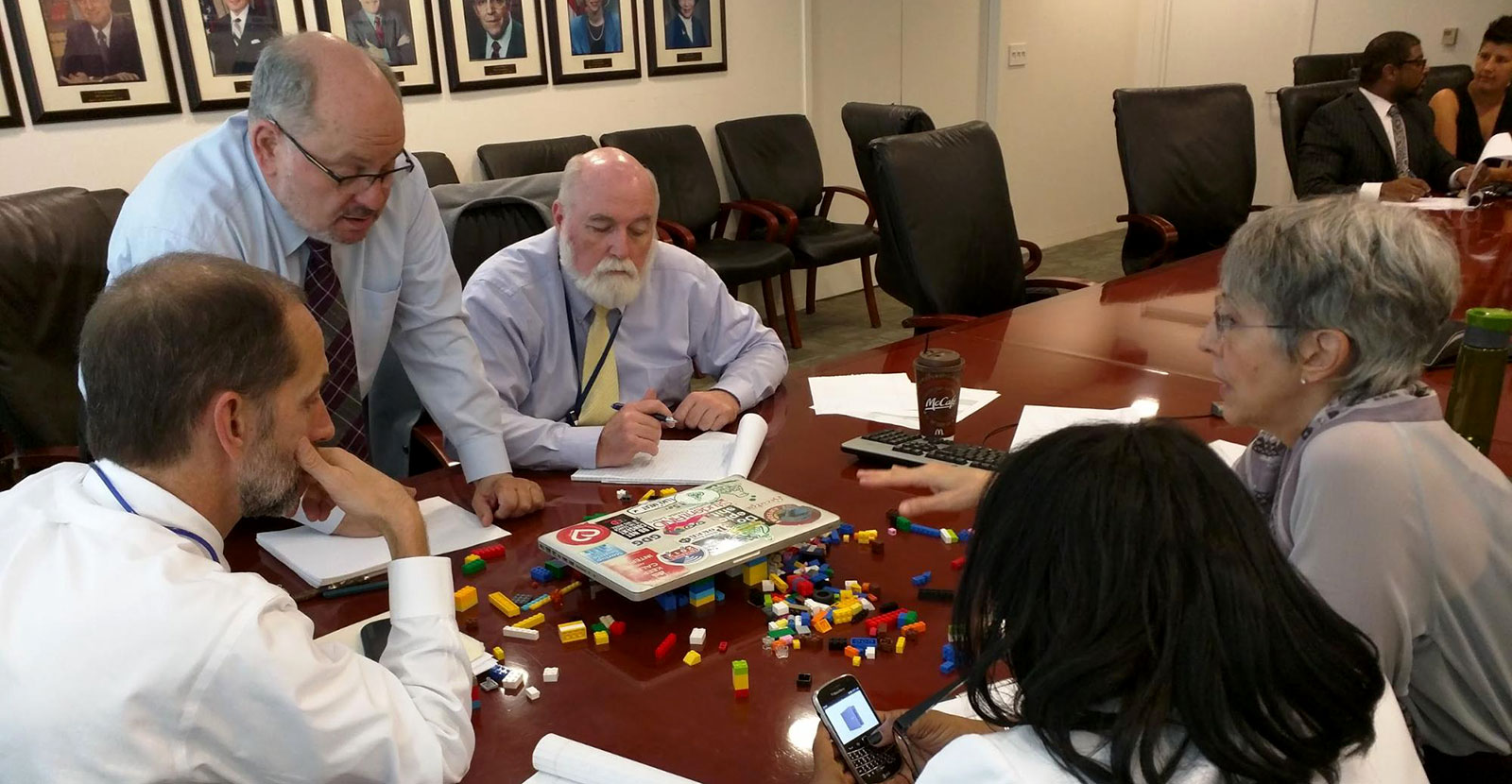 We spent 90 minutes working with legos to teach the Small Business Administration agile development.
We spent 90 minutes working with legos to teach the Small Business Administration agile development.
Process and documentation
It’s not something that often gets public attention, but we worked really hard to improve 18F’s internal processes and documentation this year. Ensuring that our daily standups run smoothly and our documentation is complete will ensure that we have the capacity to continue to learn and grow.
“I have really enjoyed working on the Team API and Hub-related initiatives because I believe that making this information easily accessible throughout 18F will help the organization continue to grow and thrive. Furthermore, this work helps put into practice the culture we’re building at 18F, which we hope that other federal agencies, contractors, and even other private organizations can learn from.” - Carlo Costino
“The best thing I’ve made this year has been working on the soon-to-be-public 18F Handbook in collaboration with my colleagues. I’ve learned so much. Creating company-wide documentation has forced me to think about how content governance relates to organizational design.” - Andrew Maier
“I loved working on our team process (stand-ups, grooming, planning, and retros). I think this helps us centralize team tasks, so we can better prioritize. It also helps us work through team issues/blockers a lot more quickly and efficiently. Creating a long-term roadmap will help even more.” - Michael Torres
“I loved working on reworking 18F’s onboarding processes. Improving onboarding dramatically improves how people work and feel about their workplace. It’s really exciting to think about how we might now scale best practices out and learn from other agencies.” - Melody Kramer
“The best thing I worked on this year was the Product Manager Guide! It’s not done yet, but we’re nearly there, and it’s awesome because it’s helping us to sync as a product team on our shared understanding while also sharing our best practices with the wider world. Portions of it will be published as an 18F Guide before the end of the year!” - Anna Heller Sebok
“I think the best thing that I’ve made this year has been the Official Guide to Travel at 18F. Taking on the complexity of Concur and the rules of government travel and splitting them into manageable steps seems to have reduced confusion as well as the amount of time spent helping people stuck in various parts of the process. I’m excited to continue the work in 2016, pinpointing the remaining areas of confusion and improving the Guide to address those.” - Ethan Heppner

Growing our team
This year, our Talent team streamlined their processes and almost doubled our workforce. They started working in agile cycles and launched a new website about applying to 18F. Several people from across 18F reflected on the work the Talent team has completed.
“I really enjoyed working with 18F Team Talent, because I discovered all of the amazing work and labor of love done to recruit, hire, and retain the most innovative talent.” - Pia Scott
“As an admin, I’m used to working on my own and not with teams, so I really enjoyed working on our new talent process with Bill, Jamie, and Esther and working through all the hiccups/issues we faced during the first sprint and how we are working on improving them for the second sprint. This work also forced me to use GitHub, which I am glad I am learning.” - Jennifer Moran
“In fiscal year 2015 with the help of our partners in the Office of Human Resources Management, the Talent team onboarded an additional 85 innovators (for a total of nearly 160 today) who are enabling agencies to rapidly deploy tools and services that are easy to use, cost efficient, and scalable. When our employees are asked, “what’s the best part of 18F?” the response is almost always: “THE PEOPLE.” We like that.” - Jen Tress
“The best thing I worked on this year was successfully recruiting some truly awesome people.” - Leah Bannon
“I helped initiate the talent team’s transformation toward innovation and product focus by introducing a work system that integrates principles and methodologies from lean and agile. (The team completed two pilot sprints and we are now working on v2.)” - Bill Rooney

